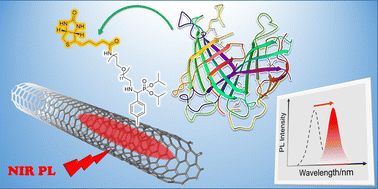Protein-structure-dependent spectral shifts of near-infrared photoluminescence from locally functionalized single-walled carbon nanotubes based on avidin–biotin interactions†
Abstract
Single-walled carbon nanotubes (SWCNTs) emit photoluminescence (PL) in the near-infrared (NIR) region (>900 nm). To enhance their PL properties, defect doping via local chemical functionalization has been developed. The locally functionalized SWCNTs (lf-SWCNTs) emit red-shifted and bright E11* PL originating from the excitons localized at the defect-doped sites. Here, we observe the E11* PL energy shifts induced by protein adsorption via the avidin–biotin interactions at the doped sites of lf-SWCNTs. We establish that the difference in the structures of the avidin derivatives notably influences the energy shifts. First, lf-SWCNT-tethering biotin groups (lf-SWCNTs-b) are synthesized based on diazonium chemistry, followed by post-modification. The responsiveness of the lf-SWCNTs-b to different microenvironments is investigated, and a correlation between the E11* PL energy shift and the induction-polarity parameters of surrounding solvents is established. The adsorption of neutravidin onto the lf-SWCNTs-b induces an increase in the induction-polarity parameters around the biotin-doped sites, resulting in the red-shift of the E11* PL peak. The E11* PL shift behaviors of the lf-SWCNTs-b change noticeably when avidin and streptavidin are introduced compared to the case with neutravidin. This is due to the different microenvironments formed at the biotin-doped sites, attributed to the difference in the structural features of the introduced avidin derivatives. Moreover, we successfully enhance the detection signals of lf-SWCNTs-b (>three fold) for streptavidin detection using a fabricated film device. Therefore, lf-SWCNTs exhibit significant promise for application in advanced protein detection/recognition devices based on NIR PL.



 Please wait while we load your content...
Please wait while we load your content...